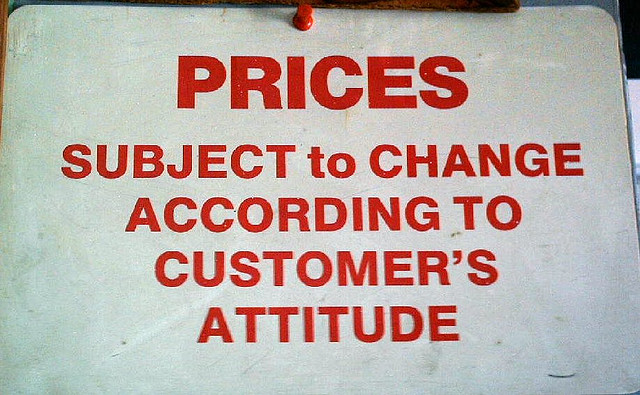What We Talk About When We Talk About Pricing
This past weekend I moderated a panel on pricing at the Creative Clubhouse. The event was a blast and the insights the panelists shared shed light on the often confounding algebra that is pricing creative work.
Here is some of the great advice they shared:
Though it can be tempting to offer discounts to attract customers, Steven Kasprzyk of Jolby & Friends warned that what you’re really telling customers when you do that is you can get by just fine selling your goods or services at a lower rate. Which is not exactly what you’d like your clients to think about you.
A dream client may come along that makes it worth your while to work at a discounted rate, but it should be just that: a Dream Client. Everyone who contacts you with potential work is not a Dream Client. Heck, everyone cool who contacts you with really exciting work is not a Dream Client. Know who those one or two people or companies are and stick to your guns with everyone else.
Artist Gwenn Seemel posts her prices online and she says it takes a lot of the worry out of pricing for both her and her clients. They know what to expect and she knows that the prices she’s charging cover the cost of the work she’s providing.
She prices based on the size of her paintings, which I’ve heard works well for a lot of painters (great post about it here) so long as the prices make sense as a whole. When Gwenn raised her prices recently, she didn’t only look at how much each size cost, but how those prices were in relation to one another. As a result the price for some sizes changed while others didn’t.
Entrepreneur and Creative Canvas creator Jena Nesbitt underscored the importance of keeping track of what you’re doing and how your sales are over time. Without data it’s really hard to know if you should raise prices, make more of a particular product, or offer something new. I can’t endorse Jena’s advice enough. Pricing can feel overwhelming. It’s a lot less so if you understand what you’ve done, what’s worked well and what hasn’t.
I personally think too many creative freelancers providing services (as opposed to goods) over look tracking data as a tool to use when determining prices. You aren’t expected to get the pricing perfect for every gig, but each gig has loads of valuable information about whether your price is working. By keeping track of that data, you’re prepared to make good decisions about how you work, instead of feeling like you’re groping in the dark to try and find your way.
Steven mentioned that one of the ways they do this at Jolby & Friends is that they figured out how much it costs them to run the business for an hour. That cost is the lowest they can possibly go on work. But that number also changes over time, so keeping track of it helps them realize when it might be time to adjust prices.
(If you do this, don’t forget to add brainstorming time in there! It’s not something you usually charge the client for, but it’s a necessary “cost” of running your business.)
Josh Kenyon, one of the founders of Jolby & Friends, was also on the panel and talked about the role that research plays in figuring out pricing. You need to understand your costs, but you also need to understand what others are charging for similar work. He encouraged people to talk to their peers and ask, “What do you charge for X?” The other person can say “No” if they don’t want to share their prices, but in his experience many people are willing to talk numbers.
What are some of your favorite pricing tips? How do you price your work?
Update: Jena Nesbitt is teaching a workshop on pricing creative work for PNCA’s BridgeLab on November 18 at 6pm. There are public tickets available and if you’re struggling with pricing at all, I strongly encourage you to attend.
Categories: The Rest
Tags: $Money$, Clients, practical advice
« When Should You Start Worrying About Getting Paid?
Two of My Favorite XOXO Talks Are on YouTube, Go Watch Them »






As a nonfiction book ghostwriter, after more than 50 books I’ve found that a flat rate pricing scheme is much, much easier than hourly. I’ve never had a single complaint about it, either. As for my rate, I share it up front, and it’s high. $40,000 for a typical book, and I have no trouble getting that. It’s all in how you present yourself. Offer value, share advice for free, and learn to be spectacular on the phone. The last one is really the key. If I get a cold call from a possible author, for example, I’ll tell him I’m too busy to chat right now but can reschedule. Then I’ll do massive research on that person so that when we talk, I know things that stun him. I’ve gotten an incredible amount of business from a single phone call.
Thanks so much for sharing your experience, Tim. I like your availability/research technique. I imagine it also helps with establishing good boundaries with your clients. I have to say that flat rate pricing makes sense to me but I’ve not figure out how to make it work in my business. I guess I should take some of my own advice and experiment with it. 🙂